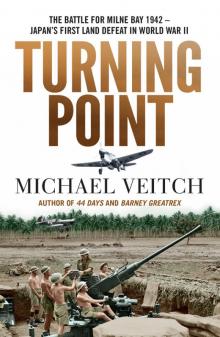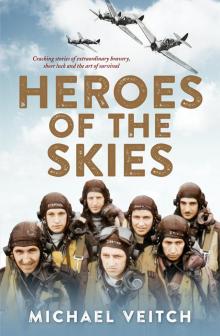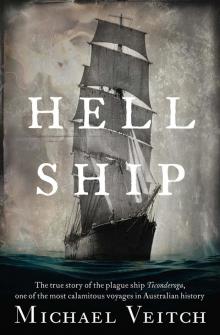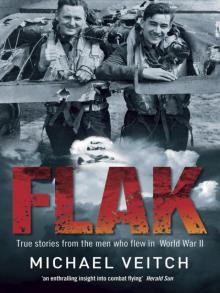- Home
- Michael Veitch
Flak Page 4
Flak Read online
Page 4
Among a pile of photographs, documents and assorted memorabilia, Dick showed me a photograph of his training course at Mallala in South Australia – row upon row of young male faces, smiling in uniform and wearing the distinctive white flash denoting a student aircrew. In a matter of fact way he mentioned that 25 per cent of them did not come home.
‘There I am in the middle,’ he told me, pointing to his younger face. ‘This is Bob Chalmers – he was from Footscray – he didn’t survive . . .’ For a few minutes Dick’s gaze travelled across the faces, some forgotten but many others remembered. ‘Jamie Cameron – a stock and station agent – survived with terrible burns after an engine failure at take-off . . .’
Dick flew his entire tour in daylight, usually in formations of six aircraft. The flight commander was number one, two and three were close on the left or right, four was close under number one, five and six with positions of their own, the entire formation stacked in a tight box providing not only mutually supportive defensive fire from its guns, but concentrating its bombing power as well. Much of Dick’s tour was completed in early 1945 when the German air force was severely weakened and often did not put up much of an appearance or fight. Number 180 Squadron was not so lucky.
Coming back from a trip to Wesel, Dick’s plane was flying low under the clouds when three Messerschmitt 109s suddenly appeared. Dick didn’t even see them, hearing only an unusual ‘ratt-a-tattat’ and instinctively drawing his elbows into his sides for protection from the armour plate at the back of his seat, only realising what they were when they roared past him and peeled away. ‘It was like seeing the grey underbelly of a shark,’ he told me. Jock Maher, new to the squadron and flying number six, was just out of the formation, about six or seven lengths over to the right, isolated from the protection of the others and a sitting target. The gunners saw it all, just one pass by the German fighters and then they were gone. Jock’s Mitchell went straight down, flames pouring out of the starboard engine and in a steep dive, too low for parachutes. There were no survivors.
Among his pictures was a photograph of Jock’s grave, taken just after the war in June 1945.
March 8 was another terrible day. Detailed to attack railway marshalling yards in Haltern, the flak over the target was dreadful. With bomb doors open, the Mitchells in Dick’s squadron attacked as one. Dick got his bombs away but then the flak found him in a box barrage and began exploding in violent grey puffs within a few feet of the aircraft, holing him several times. Barely two lengths away and slightly ahead, he remembers seeing a red flash in the aircraft next to him, then a massive bang. A burst had exploded directly inside the bomb bay of the adjacent aircraft as its bombs released, detonating the entire payload and destroying it and its crew in an instant. The close range blast made his aircraft momentarily uncontrollable but it kept flying, pelted by debris. One by one, he called the roll. All answered, shaken but unhurt. All but Tony Kendrick, one of the gunners who was hit in the knee and bleeding badly. Another crew member jabbed him with a morphine stick from the medical pack and the aircraft passed safely over the target. Then Dick noticed that all the hydraulic pressure gauges on the instrument panel were registering zero. Shrapnel had cut the lines and the entire fuselage floor was awash in the distinctive blood-red colour of hydraulic fluid, vital for the control of flaps, brakes and undercarriage.
Even before the advice from base came over the radio, the navigator was hard at work, pumping the manual undercarriage lever back and forth to lower the wheels by hand.
I asked Dick what the atmosphere was like among the crew, heading in for a potential crash-land in a stricken aircraft. Was there panic? Tears? Hysteria? He looked thoughtful for a moment.
‘Calm,’ he told me. ‘It was all very calm. Everyone knew what they had to do. Everyone had been trained. We all spoke calmly and clearly to one another and communication was good.’ At last a reassuring clunk indicated the wheels were in position.
Dick was given a priority landing and brought the aircraft in as slowly as he could without flaps, and as close as he could to the beginning of the runway. It touched down, still at a dangerous speed, and he managed to prevent it from skewing off the side of the tarmac and to an eventual halt. Immediately they were surrounded by crash tenders and ambulances. A medical officer handed him a tot of rum.
‘Give it to Tony. He needs it more than I do.’
Dick’s instructor back in Mallala would surely have been impressed.
Later, walking around the aircraft, Dick counted no less than thirty-nine holes in every part of the machine.
‘I’ve said it before and I’ll say it now: I knew I’d make it home in one piece, I knew it. I believe some power beyond human understanding was protecting me. That, and the prayers of my mother,’ said Dick with the assurance of a man safe with his convictions.
3
Allen Tyson
Air-gunner
The pilot and bomb-aimer both got the DFC. We just
got the pants scared off us.
Allen got into the air force because he already had the uniform. It wasn’t quite the right uniform but it was close enough. Originally from Broken Hill, Allen had been in the Air Training Corps cadets since he was sixteen and decided to tag along one night in 1943 with a bunch of new recruits to a draughty hall in Perth on the off chance that some other bloke hadn’t turned up. He was in luck. Although the youngest, he was taken straight in without having to wait the usual six months in the reserve between sign up and call up. He was, as they say, a keen type. He still is.
I met Allen in an aircraft museum in Perth where he works as a volunteer and as soon as he sat down he was eager to talk, delighting in recalling the events of sixty years ago as if they’d happened on the way in that morning. He reacted to my specific line of questioning as if it were a game of mental gymnastics and actually became more enthusiastic as we progressed, answering quickly, fixing me with alert, pale eyes and applying minute elaborations to his stories such as sitting in the Nullabor next to the troop train on the way over from South Australia and opening a tin of sausages in the red dust.
To train as an air-gunner, Allen, along with most air-gunners, was forced to endure one of aviation’s great misnomers, the infamous Fairey Battle light bomber. The British made some wonderful aircraft during the Second World War, but the Battle was not one of them. The biggest battle this lemon ever had was staying in the air, and at that it was usually hopeless. It’s a shame, because visually speaking, it’s always been one of my favourite aeroplanes: a low-wing monoplane with sleek lines, a single aerodynamically handsome liquid-cooled engine and long glasshouse canopy to accommodate its two occupants. It looked like a large-ish fighter, but that’s where any similarity ended. Conceived in 1932, the Battle was completely out-dated from the beginning of the war and by 1940, despite a Rolls-Royce engine, it was dreadfully underpowered, heavy, and lacked manoeuvrability. It plodded its way through the skies like grandma’s old Austin, which was in fact the factory where it was built. Add to this its lack of self-sealing fuel tanks and subsequent habit of catching fire with ease, the only thing it had going for it was the courage of the men who flew it, and this they demonstrated in spades.
The black day, or days, of the Royal Air Force were during the German invasion of France in May 1940 when, utterly overwhelmed by the Luftwaffe, they threw precious men and machines at the problem until realising what they should have known from the start of the campaign, namely that it was over, and time to retreat to fight another day. In the meantime, however, the Battle crews of Bomber Command were called upon to perform one hopeless suicidal task after another, often suffering 60 per cent losses, culminating on 12 May in an infamous low-level attack by number 12 Squadron on two bridges over the Albert Canal near Maastricht, in which the entire attacking force of six Battles was shot down. Even the Germans were appalled, reprimanding some of the captured airmen on their lack of sense (‘Why didn’t you attack before we got here to defend the bridges?’) but a
dmiring their obvious courage. Two Victoria Crosses were awarded to the Battle crews that day, one posthumously, but at least one of the bridges was destroyed. The Germans, however, put up a perfectly effective pontoon bridge the very next day.
Having wasted enough precious industrial muscle on churning out Battles (and some other lame ducks which we’ll come to later) the government at last decided to halt production and pull all remaining Battles out of squadron service, relegating them to docile tasks like training and target towing in the far corners of the globe such as Iceland, and somewhere even more remote, Australia.
That’s why at the Air Gunnery School in Port Pirie, South Australia, Allen Tyson found himself climbing into the rear cockpit of a well used Fairey Battle to acquaint himself with a World War One vintage Vickers gas-operated machine gun. With this he was expected in four short weeks to master the principles of shooting down an attacking enemy aircraft. After ten hours ten minutes flying time, he was qualified and packed off to Melbourne (via some ignominious nights billeted in the sheep pens at Ascot Vale cattle yards) to prepare for overseas embarkation.
A fast American troop ship – in actual fact a converted luxury liner – took him the first step of the long journey to England via the United States. In New York, his convoy was delayed by the German battleship Scharnhorst, which was currently running rampant in the Atlantic, so Allen and his mates were condemned to spend an all-expenses paid three weeks in New York city.
‘Must have been hard,’ I suggested.
‘Yeah. It was,’ he said, looking down and bashful, gently shaking his head. ‘We were sorry they sunk the Scharnhorst.’
Eventually he arrived in comparitively drab England to commence further instruction at an Operational Training Unit at Lichfield in Staffordshire on Wellingtons. These were long-in-the-tooth workhorses as well, but a vast step up from the Battle.
Allen handed me his log book, the same blue cloth-bound volume issued to every aircrew in which is recorded every detail and every minute of training and operational flying. Everything was in ink, entered in the meticulous handwriting of the day. Black for day trips, red for night, green for operations at sea such as mine-laying, or ‘gardening’ as it was called. It is a prized possession among anyone who flew. Every one of them I examined had been kept lovingly and were in immaculate condition. The few fellows who for various reasons had lost theirs (one had had his destroyed by a vindictive ex-wife) still felt it keenly.
Allen’s training consisted of many hours of night flying, bombing practice, fighter affiliation exercises, more bombing and seemingly endless cross-country exercises, some lasting up to five and six hours at a time. Fighter affiliation taught the principles of engaging with an enemy fighter, learning the exact moment to yell to the pilot, ‘Corkscrew port, go!’ or, ‘Corkscrew starboard!’ the name given to the manoeuvre of twisting and turning the aircraft, causing it to over-shoot before the enemy had a chance to open fire.
From Lichfield it was on to 1660 Heavy Bomber Conversion Unit at Swinderby in Lincolnshire to train further on four-engined Short Stirlings. He was now getting into the big league. One afternoon, on a training flight just before landing, the aircraft’s hydraulics failed and the wheels had to be lowered by means of an emergency system. They were diverted to an emergency runway 3 miles long and the Stirling needed every foot of it to pull up without its brakes. It was a big aircraft.
Then to Lancasters in Syerston in Nottinghamshire for a few short days to acquaint himself with the aircraft that would be his office till the end of the war, at the curiously named Lancaster Finishing School.
‘Do you remember your first op?’ I asked.
‘Yes, vividly,’ said Allen.
As mid-upper gunner in a Lancaster, Allen had the best view of the whole crew, including the pilot. Armed with two .303 inch Browning machine guns, Allen, in his clear perspex turret on top of the fuselage could revolve 360 degrees. On his first trip, though, he thought the view looked decidedly unhealthy. Allen and his crew began operating over daylight targets in France when the Allies had begun to push the Germans back home and so the bomber force were taken off the big city targets inside Germany to assist the army and attack special targets such as the flying bomb sites from which the enemy was currently attacking London.
St-Leu-d’Esserent is just north of Paris and Allen’s aircraft was one of about five hundred attacking factories set up in caves where the V1 flying bombs were being assembled with slave labour from occupied Europe. It was a beautiful day and the approaches looked peaceful. Maybe operations aren’t that hard after all, he thought. Then all of a sudden the target came up and then the flak, a storm of exploding black shellfire concentrated on a very small patch of sky, the same patch they were about to fly through. Looking forward at the barrage, he simply could not conceive how anything could get through it and until the last seconds, was convinced the pilot would go around. He still doesn’t understand how he came through. It wasn’t going to be as easy as he thought.
On his way back, the pilot gave a wide berth to the French town of Calais, a no-go zone as it had been bypassed by the army, leaving a very active German garrison free to fire at any Allied aircraft passing overhead. To his amazement, Allen watched a lone American Dakota transport, about 3,000 feet below them heading directly over the town on its way back to England. How could the crew not know about Calais? Were they lost? Or drunk? There was no way of warning the slow-flying plane so Allen simply looked on, helpless, knowing what was about to happen. As he watched safely out of range, a single shell was fired from the ground and the lumbering aircraft went down like a stone.
Soon after, he watched an entire load of bombs fall from one Lancaster directly onto another which had drifted out of its allotted bombing position in the formation. The daytime view was becoming less attractive.
Allen’s first night trip was a long flight to Stettin, a seaport on the Baltic, and on this one he reckons they could very easily have ‘bought it’ – wartime parlance for getting killed. At night, there was no formation to follow, so it was up to the navigator to find the way to the target and back home again. On the way out, the pilot noticed they had been flying along the same leg for quite some time and asked the navigator when he could expect the next turn. Usually a serious, quiet type (as many navigators were), the reply was odd to say the least – a strangely dismissive ‘Keep going, you’re right’. A while later the pilot asked again. ‘Navigator, we’ve got to turn soon.’ This time the reply was almost incoherent, a mumbled ‘Nah, we’re OK . . .’ Allen thought he must be drunk. The wireless operator went to inspect and found the navigator delirious with hypoxia, his oxygen lead unplugged. They were alone and lost somewhere over Germany with a navigator not in a fit state to care. In the distance they could see the glow of a big fire and presuming it to be Stettin, headed for it. But something was not quite right. The closer they got, the bigger the city seemed until the sudden sickening realisation: this wasn’t the relatively small city of Stettin, this was Berlin, currently under attack by a force of sleek, fast, twin-engined Mosquitos. To be the sole four-engined bomber over the German capital on such an occasion was an extremely unhealthy place to be. The pilot wrenched the aircraft around just as the navigator, oxygen restored, came good.
‘Get us out of here!’ demanded the pilot, hurtling home under the radar at low-level, hoping that a German night fighter hadn’t spotted them.
‘What are they going to think of me back in Nav section?’ seemed to be the now fully functioning navigator’s primary concern, somewhat to the annoyance of the rest of the crew.
‘Stuff Nav section,’ remonstrated the pilot, ‘just get us home.’
In September 1944, the British decided the German garrison at Calais was due for a visit. Why a low-level daylight force was chosen as the most appropriate method to deal with it was and still is beyond Allen Tyson. They hurtled across the sea so low that he saw the propeller wash churning up the channel just a few feet below. He alre
ady had a foreboding, a feeling confirmed when arriving over Calais and hearing ‘Leader Two to Master Bomber’ called repeatedly over the radio. There was no reply. Allen could see the Master Bomber already lying shot down in the harbour. A short while later it was ‘Deputy Leader Two calling Leader’. Again, no reply. Then a message was sent out to the entire formation: ‘All main force aircraft return to base’. But eight of the force of nearly two hundred aircraft missed the message, and Allen’s was one of them. Light flak opened up. Then the machine guns and everything else that could shoot. Looking out from his turret, he saw a German soldier shooting at him with a rifle. Forbidden to use the guns in his turret on ground targets in case of hitting French civilians, Allen attempted to crouch into a ball for some kind of protection. At that height the target came up quickly. At least they’d be out of there soon. Then the bomb-aimer (who had, unbeknown to Allen, already been hit by a shell fragment in the upper leg) called over the intercom, ‘We’ve got to go around again!’ Allen couldn’t believe his ears, but through they went again with two other Lancasters. Both of them were hit and shot down, plunging for barely a second at that height then hitting the ground.
‘We managed to get home but it frightened the hell out of me.’
A much longer trip – nine and a half hours in fact – was to the port of Gdynia in Poland to bomb the port and its facilities and a German battleship, the Lutzow. It was the middle of December 1944 and Europe was blanketed in white, making the port an un-missable target. The bombs were dropped all around the port and the ship but the results from the photo-reconnaissance next morning were bewildering: no evidence that the bombs had hit anything. An investigation revealed that the bombs they were carrying had been fused at the wrong height.
‘They’re probably still there under the water in Gdynia,’ says Allen.

 Turning Point
Turning Point Heroes of the Skies
Heroes of the Skies The Forgotten Islands
The Forgotten Islands Hell Ship
Hell Ship Flak
Flak Fly
Fly